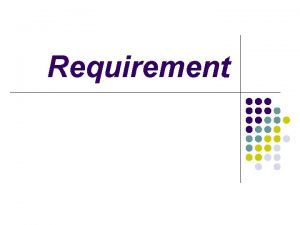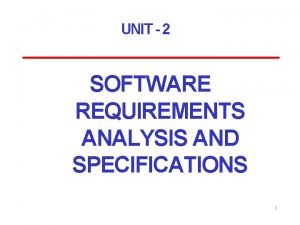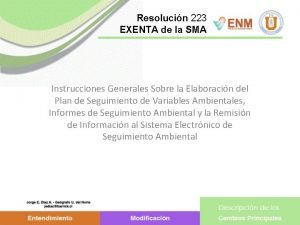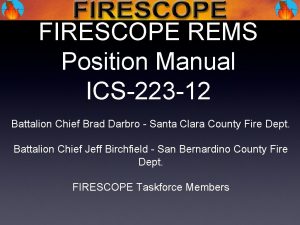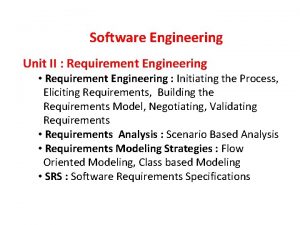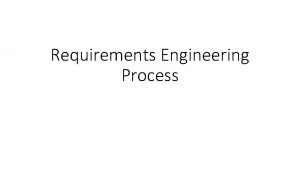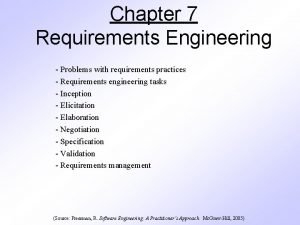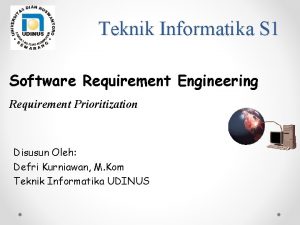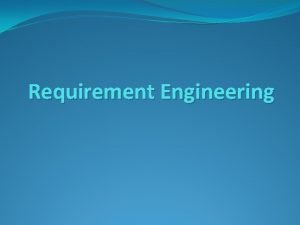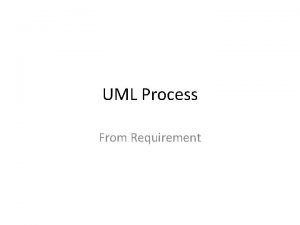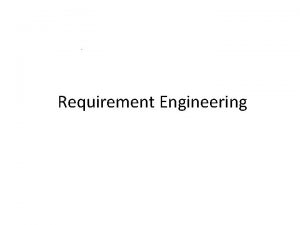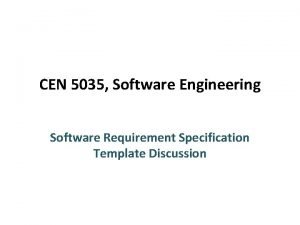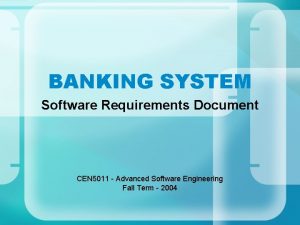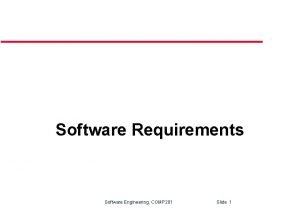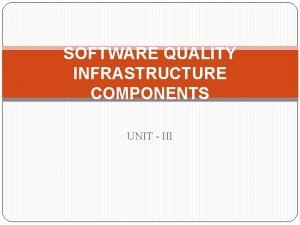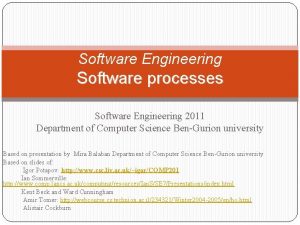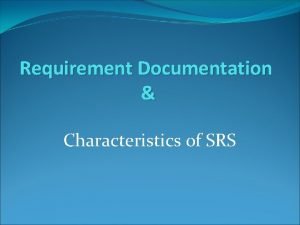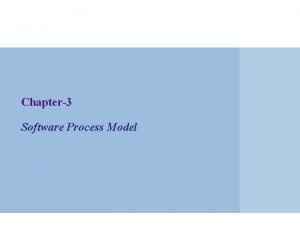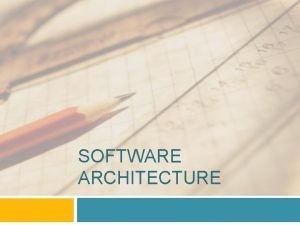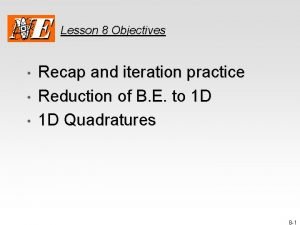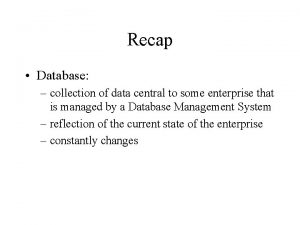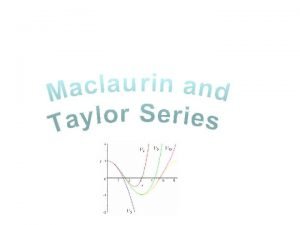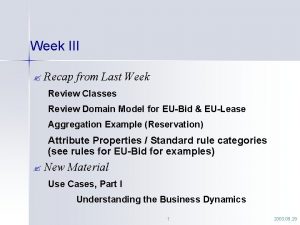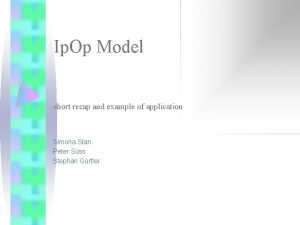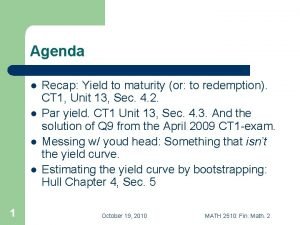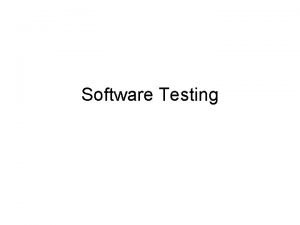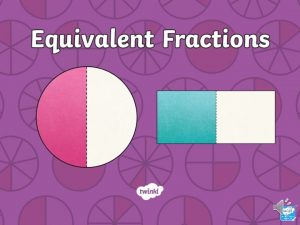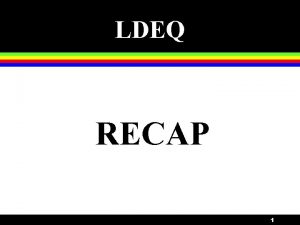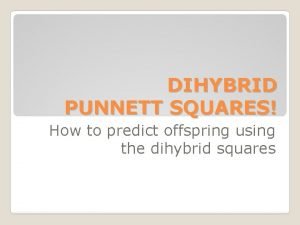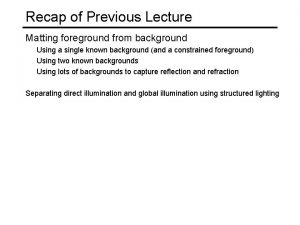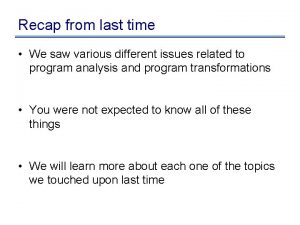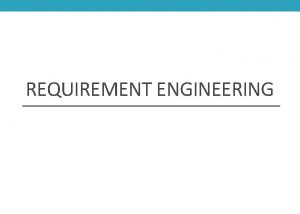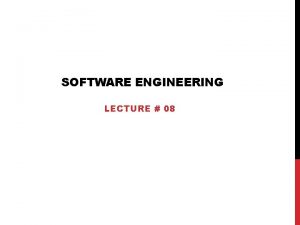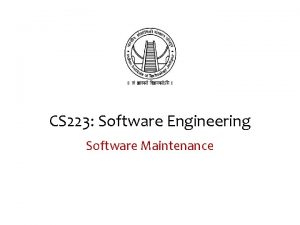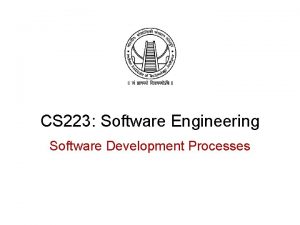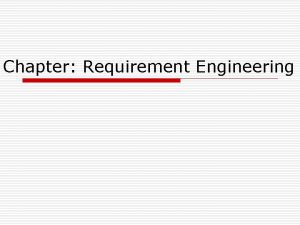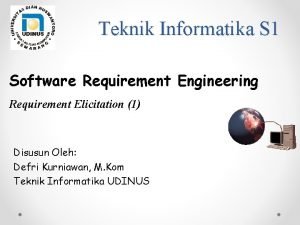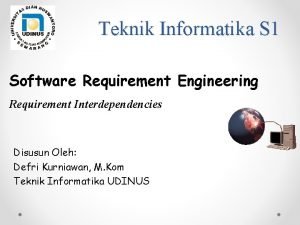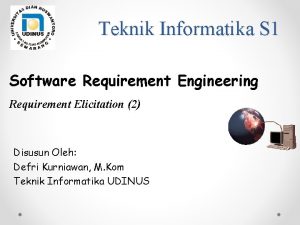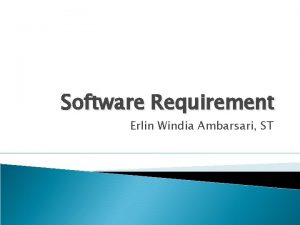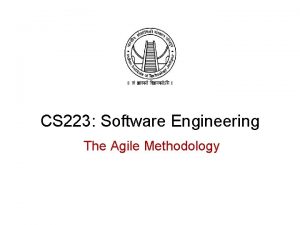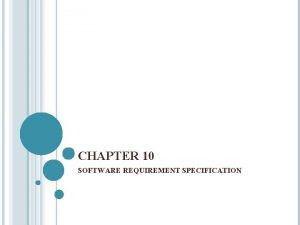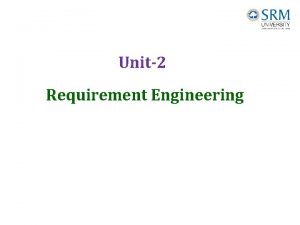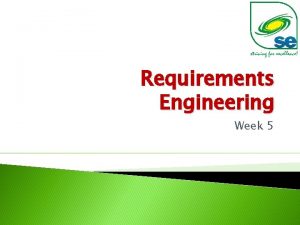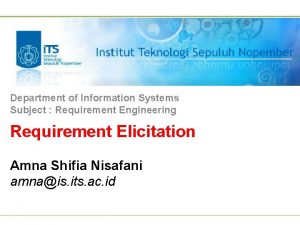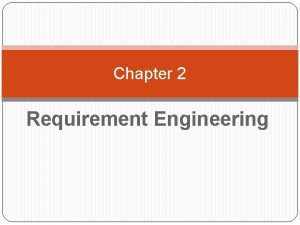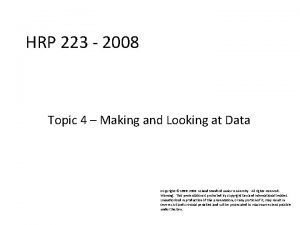CS 223 Software Engineering Software Architecture Recap Requirement




































































- Slides: 68

CS 223: Software Engineering Software Architecture

Recap • Requirement Engineering • Object oriented design • SRS writing • UML based modeling

Objective After completing this lecture the students will be able to • Explain the importance of software architecture • Identify the type of architecture to be used in their projects

Definition • The complex or carefully designed structure of something.

Architecture • It is a design of the software that gives a very high level view of parts and they relate to form the whole o Partitions the system in parts such that each part can be comprehended independently o And describes relationship between parts • A complex system can be partitioned in many different ways • Each providing a useful view o Same holds true of software also o There is no unique structure; many possible

Architecture • The structure or structures which comprise o Elements, o Their externally visible properties, and o Relationships among them • For elements only interested in o External properties needed for relationship specification o Details on how the properties are supported is not important o Does not say whether an arch is good or not o Analysis needed for it • Describes the different structures of the system

Key Uses of Arch Descriptions • Understanding and communication o By showing a system at a high level and hiding complexity of parts, arch describes facilitates communication o To get a common understanding between the diff stakeholders (users, clients, architect, designer, …) o For negotiation and agreement o Arch descr can also aid in understanding of existing systems

Uses… • Reuse o A method of reuse is to compose systems from parts and reuse existing parts o This model is facilitated by reusing components at a high level providing complete services o To reuse existing components, arch must be chosen such that these components fit together with other components o Hence, decision about using existing components is made at arch design time

Uses. . • Construction and evolution o Some structures in arch description will be used to guide system development o Partitioning at arch level can also be used for work allocation to teams as parts are relatively independent o During s/w evolution, arch helps decide what needs to be changed to incorporate the new changes/features o Arch can help decide what is the impact of changes to existing components on others

Uses… • Analysis o If properties like performance, reliability can be determined from design, alternatives can be considered during design to reach the desired perf levels o S/w arch opens such possibilities for software (other engg. disciplines usually can do this) o E. g. Performance of a system can be predicted from its arch, if estimates for params. like load etc. is provided o Will require precise description of arch, as well as properties of the elements in the description

Architectural Views • There is no unique arch of a sys • There are different views of a s/w sys • A view consists of elements and relationships between them, and describes a structure • The elements of a view depends on what the view wants to highlight • Diff views expose diff properties • A view focusing on some aspects reduces its complexity

Views… • Many types of views have been proposed • Most belong to one of these three types o Module o Component and Connector o Allocation • The diff views are not unrelated – they all represent the same system o There are relationships between elements of diff views; this relation may be complex

Views… • Module view o A sys is a collection of code units i. e. they do not represent runtime entities o I. e. elements are modules, eg. Class, package, function, procedure, … o Relationship between them is code based, e. g. part of, depends on, calls, generalization-specialization, . .

Views… • Component and Connector (C&C) o Elements are run time entities called components o I. e. a component is a unit that has identity in executing sys, e. g. objects, processes, . exe, . dll o Connectors provide means of interaction between components, e. g. pipes, shared memory, sockets

Views… • Allocation view o Focuses on how sw units are allocated to resources like hw, file system, people o I. e. specifies relationship between sw elements and execution units in the env o Expose structural properties like which process runs on which processor, which file resides where, …

Views… • An arch description consists of views of diff types, each showing a diff structure o Diff sys need diff types of views depending on the needs o E. g. for perf analysis, allocation view is necessary; for planning, module view helps • The C&C view is almost always done, and has become the primary view o We focus primarily on the C&C view o Module view is covered in high level design, whose focus is on identifying modules

Component and Connector View • Two main elements – components and connectors • Components: Computational elements or data stores • Connectors: Means of interaction between comps • A C&C view defines the comps, and which comps are connected through which connector • The C&C view describes a runtime structure of the system – what comps exist at runtime and how they interact during execution • Is a graph; often shown as a box-and-line drawing • Most commonly used structure

Components • Units of computations or data stores • Has a name, which represents its role, and provides it identity • A comp may have a type; diff types rep by diff symbols in C&C view • Comps use ports (or interfaces) to communicate with others • An arch can use any symbols to rep components; some common ones are shown

Some Component examples…

Connectors • Interaction between components happen through connectors • A connector may be provided by the runtime environment, e. g. procedure call • But there may be complex mechanisms for interaction, e. g http, tcp/ip, ports, …; a lot of sw needed to support them • Important to identify them explicitly; also needed for programming comps properly

Connectors… • Connectors need not be binary, e. g. a broadcast bus • Connector has a name (and a type) • Often connectors represented as protocol – i. e. comps need to follow some conventions when using the connector • Best to use diff notation for diff types of connectors; all connectors should not be shown by simple lines

Connector examples

An Example • Design a system for taking online survey of students on campus o Multiple choice questions, students submit online o When a student submits, current result of the survey is shown • Is best built using web; a 3 -tier architecture is proposed o Has a client, server, and a database components (each of a diff type) o Connector between them are also of diff types

Example…

Example… • At arch level, details are not needed • The connectors are explicitly stated, which implies that the infrastructure should provide http, browser, etc. • The choice of connectors imposes constraints on how the components are finally designed and built

Extension 1 • This arch has no security – anyone can take the survey • We want that only registered students can take the survey (at most once) o To identify students and check for one-only submission, need a authentication server o Need to use cookies, and server has to be built accordingly (the connector between server and auth server is http with cookies)

Extension 1…

Extension 2 • It was found that DB is frequently down • For improving reliability, want that if DB is down, student is given an older survey result and survey data stored • The survey data given can be outdated by at most 5 survey data points • For this, will add a cache comp, which will store data as well as results

Extension 2…

Example… • One change increased security, 2 nd increased performance and reliability • I. e. Arch level choices have a big impact on system properties • That is why, choosing a suitable arch can help build a good system

Architectural design • Represents the link between specification and design processes. • Carried out in parallel with some specification activities. • Identifies major system components and their communications. • Advantage of explicit architecture design ? Ref: Ian Sommerville, Software Engineering, Ninth Edition, Addison-Wesley, 2011

The architecture of a packing robot control system Vision System Object Identification System Arm Controller Gripper Controller Packaging selection system Packing system Conveyor controller

Architectural abstraction • Architecture in the small o architecture of individual programs. o how an individual program is decomposed into components. • Architecture in the large o architecture of complex enterprise systems Ø include other systems, programs, and program components. o These systems are distributed over different computers Ø may be owned and managed by different companies.

Architectural design decisions • Is there a generic application architecture that can be used? • How will the system be distributed? • What architectural styles are appropriate? • What approach will be used to structure the system? • How will the system be decomposed into modules? • What control strategy should be used? • How will the architectural design be evaluated? • How should the architecture be documented?

Architecture and system characteristics • Performance o Localize critical operations and minimize communications. Use large rather than fine-grain components. • Security o Use a layered architecture with critical assets in the inner layers. • Safety o Localize safety-critical features in a small number of sub-systems. • Availability o Include redundant components and mechanisms for fault tolerance. • Maintainability o Use fine-grain, replaceable components.

Architectural patterns • Means of representing, sharing and reusing knowledge. • Stylized description of good design practice o Tried and tested in different environments. • Information about when they are and when the are not useful. • Represented using tabular and graphical descriptions.

Model-View-Controller (MVC) Name Description When used Advantages Disadvantages MVC (Model-View-Controller) • Separates presentation and interaction from the system data. • The system is structured into three logical components • The Model component manages the system data and associated operations on that data. • The View component defines and manages how the data is presented to the user. • The Controller component manages user interaction • There are multiple ways to view and interact with data. • The future requirements for interaction and presentation of data are unknown. • Allows the data to change independently of its representation. • Supports presentation of the same data in different ways Can involve additional code and code complexity when the data model and interactions are simple.

The organization of the Model-View. Controller

Web application architecture using the MVC pattern

Layered architecture • Used to model the interfacing of sub-systems. • Organises the system into a set of layers (or abstract machines) o Each of which provide a set of services. • Supports the incremental development of sub-systems in different layers. • When a layer interface changes, only the adjacent layer is affected. • Often artificial to structure systems in this way.

The Layered architecture pattern Name Layered architecture Description • Organizes the system into layers with related functionality associated with each layer. • A layer provides services to the layer above it When used • Building new facilities on top of existing systems; • The development is spread across several teams • There is a requirement for multi-level security. Advantages • Allows replacement of entire layers so long as the interface is maintained. • Redundant facilities can be provided in each layer to increase the dependability of the system. Providing a clean separation between layers is often difficult and a high-level layer may have to interact directly with lower-level layers rather than through the layer immediately below it. Disadvantages

A generic layered architecture User Interface User interface management (Authentication and authorization) Business logic/ application utilities System support (OS, database, etc. )

The architecture of the LIBSYS system

Repository architecture • Sub-systems must exchange data. • This may be done in two ways: o Shared data is held in a central database or repository and may be accessed by all sub-systems; o Each sub-system maintains its own database and passes data explicitly to other sub-systems. • When large amounts of data are to be shared, o The repository model of sharing is most commonly used o This is an efficient data sharing mechanism.

The Repository pattern Name Repository Description • • When used • Advantages • • • Disadvantages • • All data in a system is managed in a central repository Accessible to all system components. Components interact only through the repository. Large volumes of information are generated that has to be stored for a long time. The inclusion of data in the repository triggers an action or tool. Components can be independent Changes made by one component can be propagated to all components. All data can be managed consistently (e. g. , backups done at the same time) as it is all in one place. The repository is a single point of failure so problems in the repository affect the whole system. Distributing the repository across several computers may be difficult.

A repository architecture for an IDE

Client-server architecture • Distributed system model • It shows how data and processing is distributed across a range of components. o Can be implemented on a single computer. • Set of stand-alone servers which provide specific services such as printing, data management, etc. • Set of clients which call on these services. • Network which allows clients to access servers.

The Client–server pattern Name Client-server Description • • When used Advantages • • • Disadvantages • • • The functionality of the system is organized into services Each service delivered from a separate server. Clients are users of these services and access servers Used when data in a shared database has to be accessed from a range of locations. The load on a system is variable. Servers can be distributed across a network. General functionality can be available to all clients and does not need to be implemented by all services. Each service is a single point of failure so susceptible to denial of service attacks or server failure. Performance may be unpredictable because it depends on the network as well as the system. May be management problems if servers are owned by different organizations.

A client–server architecture for a film library

Pipe and filter architecture • Functional transformations process their inputs to produce outputs. • May be referred to as a pipe and filter model (as in UNIX shell). • Variants of this approach are very common. • Transformations are sequential, o this is a batch sequential model o extensively used in data processing systems. • Not really suitable for interactive systems.

The pipe and filter pattern Name Pipe and filter Description • The processing of the data in a system is organized so that each processing component (filter) is discrete and carries out one type of data transformation. • The data flows (as in a pipe) from one component to another for processing. • Data processing applications (both batch- and transactionbased). • Easy to understand supports transformation reuse. • Workflow style matches the structure of many business processes. • Evolution by adding transformations is straightforward. • Can be implemented as either a sequential or concurrent system. The format for data transfer has to be agreed upon between communicating transformations. Each transformation must parse its input and un-parse its output to the agreed form. When used Advantages Disadvantages

An example of the pipe and filter architecture

Application architectures • Application systems are designed to meet an organizational need. • As businesses have much in common, their application systems also tend to have a common architecture that reflects the application requirements. • A generic application architecture is o An architecture for a type of software system Ø that may be configured and Øadapted to create a system that meets specific requirements.

Use of application architectures • As a starting point for architectural design. • As a design checklist. • As a way of organizing the work of the development team. • As a means of assessing components for reuse. • As a vocabulary for talking about application types.

Examples of application types • Data processing applications o Data driven applications that process data in batches without explicit user intervention during the processing. o E. g. payroll, billing, accounting, and publicity • Transaction processing applications o Data-centred applications that process user requests and update information in a system database. o E. g. e-commerce systems, information systems and booking systems.

Examples of application types • Event processing systems o Applications where system actions depend on from the system’s environment. interpreting events o E. g. games, editing systems, real time systems. • Language processing systems o Applications where the users’ intentions are specified in a formal language that is processed and interpreted by the system. o E. g. compilers

Transaction processing systems • Process user requests for information o from a database o to update the database. • From a user perspective a transaction is: o Any coherent sequence of operations that satisfies a goal; o For example - find the times of flights from London to Paris. • Users make asynchronous requests for service o Processed by a transaction manager.

Transaction processing applications input-process-output structure

The software architecture of an ATM system

Middleware for transaction management

Language processing systems • Accept a natural or artificial language as input and generate some other representation of that language. • May include an interpreter to act on the instructions in the language that is being processed. • Used in situations where the easiest way to solve a problem is to describe an algorithm or describe the system data o Meta-case tools process tool descriptions, method rules, etc and generate tools.

The architecture of a language processing system

Compiler components • A lexical analyzer o takes input language tokens and converts them to an internal form. • A symbol table o holds information about the names of entities (variables, class names, object names, etc. ) used in the text that is being translated. • A syntax analyzer o checks the syntax of the language being translated. • A syntax tree o an internal structure representing the program being compiled.

Compiler components • A semantic analyzer o uses information from the syntax tree and the symbol table o to check the semantic correctness of the input language text. • A code generator o walks’ the syntax tree and generates abstract machine code.

A pipe and filter compiler architecture

A repository architecture for a language processing system

Key points • Models of application systems architectures help us o understand compare applications, o validate application system designs and o assess large-scale components for reuse. • Transaction processing systems are interactive systems that o allow information in a database to be remotely accessed o modified by a number of users. • Language processing systems are used to o translate texts from one language into another o to carry out the instructions specified in the input language. o They include a translator and an abstract machine that executes the generated language.

Thank you Next Lecture: Software Construction
 Contoh user requirement
Contoh user requirement Requirement validation in software engineering
Requirement validation in software engineering Requirement analysis diagram
Requirement analysis diagram Requirement analysis in software engineering notes
Requirement analysis in software engineering notes Requirement analysis steps in software engineering
Requirement analysis steps in software engineering Requirement analysis plan
Requirement analysis plan Dl 11cd
Dl 11cd Resolución 223 sma
Resolución 223 sma Exord server
Exord server Ics 223-12
Ics 223-12 Requirement engineering
Requirement engineering Requirements engineering process
Requirements engineering process Spiral view of requirement engineering process
Spiral view of requirement engineering process Seven distinct tasks to requirements engineering
Seven distinct tasks to requirements engineering Contoh requirement
Contoh requirement Requirement inception
Requirement inception Requirement engineering adalah
Requirement engineering adalah Pengertian rekayasa kebutuhan
Pengertian rekayasa kebutuhan Requirement engineering
Requirement engineering Elaboration in requirement engineering
Elaboration in requirement engineering Requirement engineering template
Requirement engineering template Explain architecture business cycle
Explain architecture business cycle Data centered architecture
Data centered architecture Software requirement specification for banking system
Software requirement specification for banking system Software requirement and design
Software requirement and design Software requirement and design
Software requirement and design Software requirement and design
Software requirement and design Characteristics of documentation
Characteristics of documentation Model couples the iterative nature of prototype
Model couples the iterative nature of prototype Software specification
Software specification Software requirement analysis and specification
Software requirement analysis and specification Repository architecture in software engineering
Repository architecture in software engineering Data-centered architecture
Data-centered architecture What is system in software engineering
What is system in software engineering Forward engineering in software engineering
Forward engineering in software engineering The shawshank redemption summary
The shawshank redemption summary Gatsby l
Gatsby l Price is right recap
Price is right recap What is the purpose of an iteration recap?
What is the purpose of an iteration recap? Recap intensity clipping
Recap intensity clipping 60 minutes recap
60 minutes recap Recap database
Recap database Differentiation recap
Differentiation recap Sample script for recapitulation
Sample script for recapitulation Recap introduction
Recap introduction Recap from last week
Recap from last week The crucible act 1 socratic seminar questions
The crucible act 1 socratic seminar questions Ezekiel cheever motivation
Ezekiel cheever motivation Logbook recap example
Logbook recap example Ytm recap
Ytm recap Black box recap
Black box recap Fractions recap
Fractions recap Recap
Recap This is the horizontal axis in a coordinate graph.
This is the horizontal axis in a coordinate graph. Recap indexing scans
Recap indexing scans Just a quick recap of what we discussed
Just a quick recap of what we discussed Recap poster
Recap poster What is a essay
What is a essay Ldeq recap
Ldeq recap Pee paragraph romeo and juliet
Pee paragraph romeo and juliet Recap accounting
Recap accounting Example of recap
Example of recap Let's recap
Let's recap Let's recap
Let's recap Foil method biology
Foil method biology Recap background
Recap background Non cognitivism
Non cognitivism Saw recap
Saw recap Briefly recap
Briefly recap
